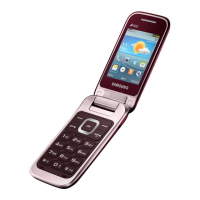
Do you have a question about the Samsung GT-C3592 and is the answer not in the manual?
| Network | GSM |
|---|---|
| Type | TFT, 256K colors |
| Call records | Yes |
| RAM | No |
| Primary | 2 MP |
| Video | Yes |
| Loudspeaker | Yes |
| 3.5mm jack | Yes |
| WLAN | No |
| Radio | FM radio |
| Messaging | SMS, MMS, Email |
| Browser | WAP 2.0/xHTML |
| Games | Yes |
| Java | Yes |
| Stand-by | Up to 600 h |
| Status | Available |
| 2G bands | GSM 850 / 900 / 1800 / 1900 |
| SIM | Dual SIM (Mini-SIM) |
| Size | 2.4 inches |
| Resolution | 240 x 320 pixels |
| Memory Card slot | microSD |
| Phonebook | Yes |
| Alert types | Vibration, MP3 ringtones |
| Bluetooth | A2DP |
| USB | microUSB |
| Battery | Li-Ion 1000 mAh |
| Colors | Black, White |
Advises keeping the phone away from small children and pets due to choking hazards.
Provides guidelines for safe handling, charging, and disposal of batteries.
Recommends maintaining distance between phones and pacemakers.
Warns against using the phone near fuels, chemicals, or in blasting areas.
Advises against phone use while driving and suggests hands-free accessories.
Advises turning off the phone in hospitals due to potential interference.
Instructs to switch off the phone or disable wireless functions on aircraft.
Warns against extreme temperatures and contact with metal objects.
States that unauthorized service voids the warranty and can cause damage.
Suggests planning alternate communication methods for remote areas.
Explains SAR, FCC limits, and testing procedures for RF exposure.
Discusses FDA's role, RF exposure, and potential health hazards of wireless phones.
Explains FDA's authority and actions regarding wireless phone safety.
Offers practical advice to minimize RF exposure, like using a headset.
Discusses phone interference with pacemakers, defibrillators, and hearing aids.
Tips for using phone while driving, including hands-free and call management.
Recommends maintaining distance from pacemakers to avoid interference.
Specific guidelines for users with pacemakers regarding phone distance.
Advises switching off the phone in areas with explosive atmospheres.
Provides step-by-step instructions for making an emergency call.
States device complies with FCC rules and may cause interference.
Emphasizes that only qualified personnel should service or install the phone.
Prohibits storing flammable, gaseous, or explosive materials with the phone.
Warns against placing equipment in air bag deployment areas to prevent injury.
States that using phones on aircraft is illegal and dangerous.
Covers using approved batteries/chargers, charging times, and battery wear.
Advises on proper disposal of used batteries according to local regulations.
Instructions for charging the battery for the first time, including indicators.
Guides on how to power the phone on and off.
Instructions for dialing a phone number and initiating a call.
How to receive and answer an incoming call.
Steps to search for and connect with other Bluetooth-enabled devices.
Instructions for entering PINs and completing the pairing process.
Guides on choosing USB modes like PC Studio, Media Player, or Mass Storage.
Lists common messages like 'Insert SIM card' or 'Phone lock' and their solutions.
Troubleshooting steps for 'Network unavailable' or 'Network error' messages.
Solutions for issues where calls are not dialled.
Troubleshooting steps for when other callers cannot reach you.
Solutions for when the other caller cannot hear you speaking.